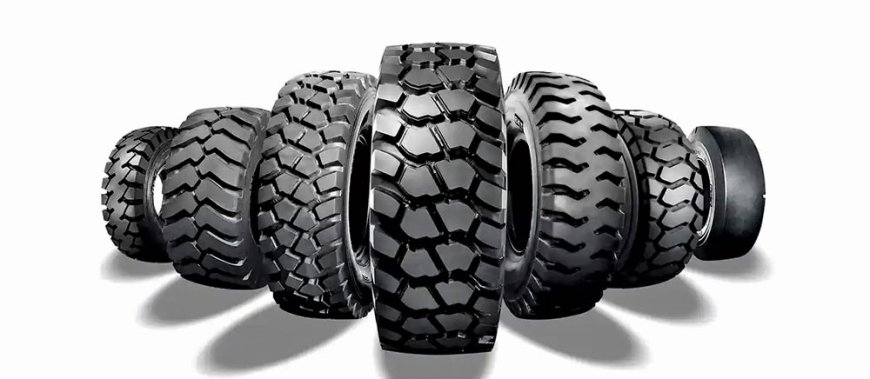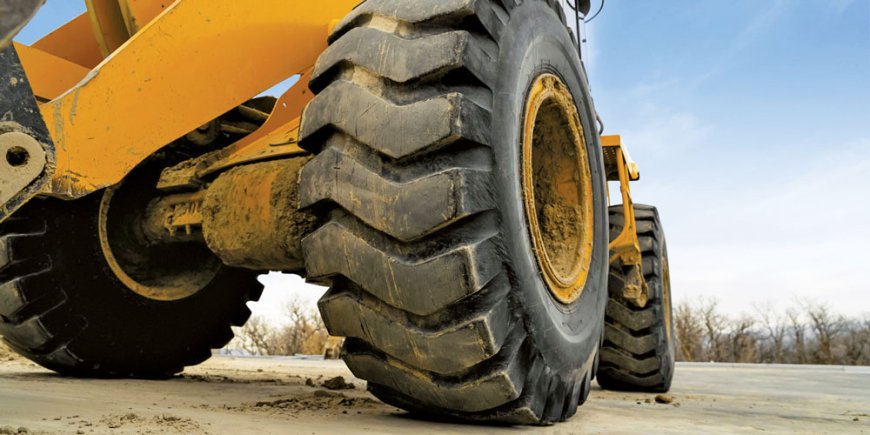INNOVATION IN MOTION! OTR Tires Powering Progress in Construction and Mining Equipment

In the era of construction and mining, where machinery operates in some of the harshest and most unforgiving environments, the importance of Off-The-Road (OTR) tires cannot be overstated. These heavy-duty tires are critical components, bearing immense loads, traversing rocky and abrasive terrains, and enduring extreme temperatures—all while maintaining optimal performance and safety. As infrastructure projects multiply and the demand for minerals intensifies, the OTR tire market is experiencing rapid growth, driven by the need for durability, efficiency, and sustainability.
Equipment Times explores the latest trends, technological innovations, and operational challenges shaping the OTR tire industry, while offering a glimpse into its future trajectory.
The world of Off-The-Road (OTR) tires is a critical one, deeply embedded in the infrastructure that shapes the modern world. From massive earthmovers to rugged dump trucks and sophisticated mining equipment, OTR tires are the unsung heroes ensuring optimal performance and safety across harsh and demanding terrains. In the construction and mining sectors, where equipment faces punishing conditions daily, the evolution and engineering of OTR tires have never been more crucial.
Market Overview and Demand Trends
The OTR tire market is witnessing significant expansion, driven by burgeoning infrastructure projects and the need for efficient material handling in mining. As urbanization and industrial activities rise, the demand for robust and durable tires continues to soar. In recent years, emerging economies in Asia-Pacific and Africa have become pivotal markets, with investments in road networks, urban infrastructure, and mineral exploration fueling this growth.
Additionally, the global focus on sustainability is reshaping the landscape. Construction and mining companies are seeking tires that deliver not only exceptional durability and load-bearing capacity but also reduced environmental impact through fuel efficiency and longer lifespans.
The OTR (Off-The-Road) tire market in India is witnessing significant growth, driven by increased demand from sectors such as construction, mining, agriculture, and material handling. With the rise of infrastructure development, mining activities, and mechanized agriculture, OTR tires are becoming essential for heavy machinery and equipment like dump trucks, excavators, loaders, and graders.
In India, the market is forecast to grow steadily, with key manufacturers like CEAT, Apollo Tires, JK Tyre, and MRF being major players. Radial tires are gaining popularity due to their superior durability and efficiency, which are crucial in the heavy-duty operations typical of OTR tire applications
The construction sector, including equipment such as backhoe loaders and asphalt finishers, is one of the largest consumers of OTR tires. Additionally, demand from the mining industry is robust, owing to its requirement for high-performance tires for mining trucks and specialized machinery.
However, challenges like the availability of cheaper unbranded alternatives from the unorganized sector and the need for advanced tire technologies for better safety and performance are notable
In terms of market segmentation, tires for construction equipment, especially articulated dump trucks and crawler excavators, are seeing high demand. The shift towards premium, durable tires designed for the harsh conditions in mining and construction projects is a key factor contributing to the market's growth
The outlook remains positive with a growing trend toward sustainable tire manufacturing practices and a significant rise in aftermarket sales, especially as businesses focus more on equipment longevity
Technological Innovations
Innovation is the backbone of the OTR tire industry. Tire manufacturers are pushing the boundaries of technology to provide products that can withstand abrasive conditions while enhancing machine efficiency. Here are some cutting-edge advancements:
Advanced Tread Design: Modern OTR tires are equipped with specialized tread patterns that improve traction and self-cleaning capabilities, essential for construction sites laden with mud, gravel, and debris. Enhanced sidewall protection is also a major focus, preventing cuts and damage that can result in costly downtime.
Compound Engineering: Tire compounds are now engineered for higher resistance to wear and heat. Innovations in rubber mixing techniques ensure that tires maintain flexibility under extreme temperatures while offering superior cut resistance in rocky terrains, common in mining applications.
Smart Tires and Monitoring Systems: With the advent of digitalization in construction and mining, smart OTR tires embedded with sensors are becoming a reality. These sensors monitor critical parameters such as tire pressure, temperature, and tread depth, alerting operators of any abnormalities. Such technology not only enhances safety but also maximizes tire life and minimizes the risk of blowouts.
Eco-friendly Initiatives: Tire manufacturers are embracing eco-friendly practices by incorporating recycled materials and developing retreading solutions. Retreading, the process of replacing the tread on worn tires, extends the tire’s usable life and reduces waste, aligning with the industry's shift towards sustainability.

Operational Challenges and Solutions
While advancements in tire technology are promising, OTR tires still face operational challenges. The harsh terrains of construction sites and mining fields test the limits of even the most resilient tires. Frequent exposure to sharp rocks, corrosive chemicals, and heavy loads necessitates meticulous maintenance and monitoring.
To combat these challenges, companies are investing in comprehensive tire management programs. These programs include routine inspections, proper tire inflation practices, and strategic rotation schedules to ensure even wear and tear. Training equipment operators on tire care has also become a priority, as incorrect handling and overloading can drastically reduce tire life.
Durability
The durability of OTR (Off-the-Road) tyres is influenced by several factors, including:
Quality of Material: High-quality rubber compounds, reinforced with materials like steel, can increase the lifespan of OTR tyres, ensuring they can withstand heavy-duty applications.
Load Capacity: OTR tyres designed for heavier loads tend to last longer under appropriate usage conditions. Overloading or using tyres beyond their rated capacity can cause premature wear and reduce their durability.
Operating Conditions: The environment plays a significant role in tyre life. Harsh terrains, such as rocky, sharp-edged surfaces or extreme weather conditions, can accelerate wear. Additionally, operating at high speeds or under high temperature conditions may also reduce durability.
Maintenance: Regular maintenance, such as checking tyre pressure, alignment, and tread wear, can extend the lifespan of OTR tyres. Under-inflation and improper tire alignment can lead to uneven wear, reducing their durability.
Tread Design: The type of tread design affects durability. Some treads are optimized for specific tasks (e.g., excavation, mining, or construction) and can improve traction and wear resistance, thereby enhancing the tyre's lifespan.
Type of Equipment: The kind of machinery the tyres are mounted on also impacts durability. For example, tyres on mining trucks experience more stress and wear than those used in construction equipment due to different operational demands.
Usage Intensity: Continuous, high-impact usage (such as in mining operations) leads to faster wear. Moderate, controlled use typically extends the lifespan.
In summary, to maximize the durability of OTR tyres, it is important to use high-quality tyres suited to the specific application, maintain proper tire care practices, and avoid conditions that cause excessive wear or damage.
Longevity and Performance
The longevity of OTR tires is influenced by several factors, from the terrain type to load frequency. Proper inflation is paramount; under-inflation can lead to sidewall damage and increased fuel consumption, while over-inflation may cause tread wear and a higher risk of punctures.
Tire specialists recommend using tire pressure monitoring systems (TPMS) to automate pressure checks and ensure optimal performance. The right tire selection, tailored to specific applications, can also make a considerable difference. For example, radial tires, known for their durability and fuel efficiency, are preferred in long-haul mining applications, whereas bias-ply tires, with superior cut resistance, are often used in more aggressive, short-haul construction tasks.
Future Outlook
The future of OTR tires lies in balancing performance with environmental responsibility. As regulatory standards for emissions tighten and companies commit to reducing their carbon footprints, tire manufacturers will need to innovate even further. We can expect continued research into alternative materials, such as bio-derived rubber compounds, and more sophisticated tire recycling processes.
Additionally, the integration of artificial intelligence (AI) in tire management could revolutionize maintenance practices. Predictive analytics may soon enable real-time assessments of tire conditions, foreseeing issues before they arise and thereby improving operational efficiency and safety.
OTR tires are indispensable to the construction and mining industries. As these sectors continue to evolve and tackle new challenges, tire manufacturers are stepping up, transforming tires from simple rubber products into high-tech solutions capable of driving progress under the harshest conditions. The focus remains on creating tires that are stronger, smarter, and more sustainable, ultimately helping the world build and mine more efficiently.
The journey of OTR tire innovation is far from over. As construction and mining needs grow ever more complex, the development of tires tailored for durability, safety, and environmental impact will be a testament to human ingenuity in meeting industrial demands while preserving the planet.








